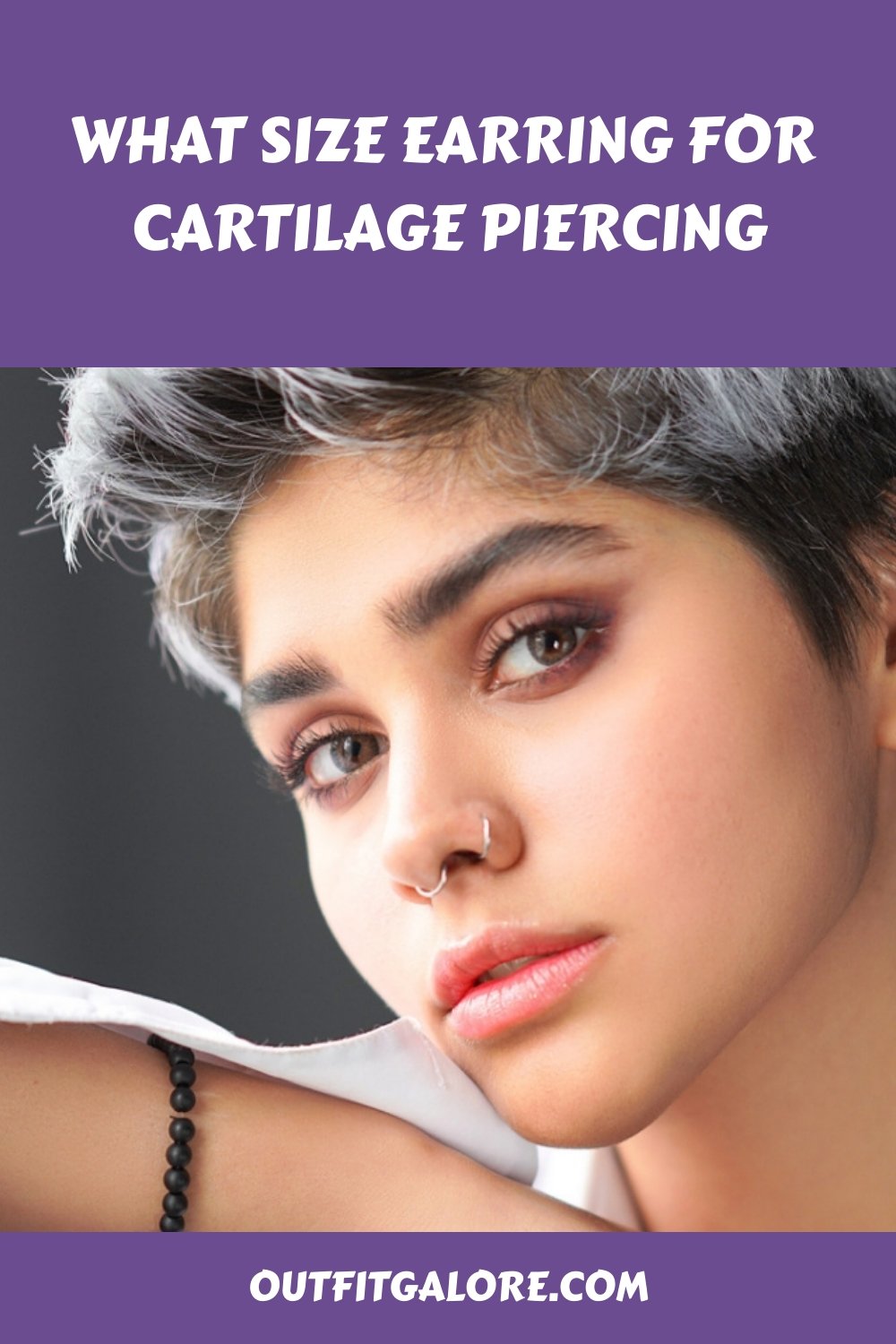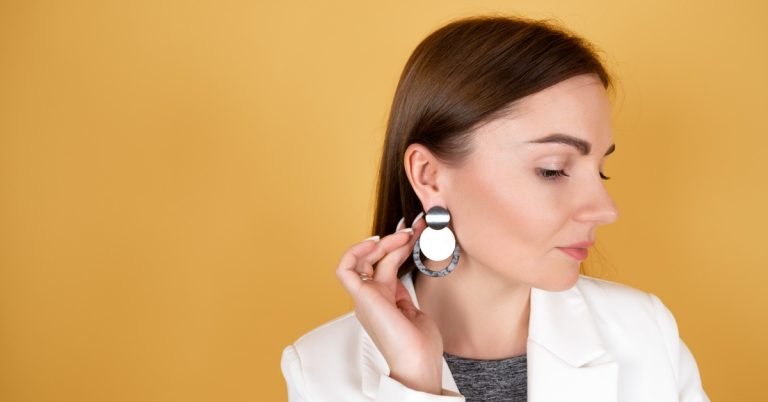No products in the cart.
What Size Earring For Cartilage Piercing
by Outfit Galore
In this article, we’ll explore the various sizes of earrings and styles available for cartilage piercings, as well as tips on how to select the perfect fit for you. We’ll also discuss safety and care considerations so that you can enjoy your piercing without any worries.

Piercing your cartilage can be a fun and stylish way to express yourself. It’s important to make sure you get the right size earring for your piercing. There are many factors to consider when choosing an earring, from safety concerns to style preferences.
Read on to learn more about what size earring is best suited for your cartilage piercing!
Table of Contents
Key Takeaways
- The size of the earring selected should be based on the type and location of the cartilage piercing.
- Smaller gauges tend to heal more quickly than larger ones, while thicker gauges offer more stability.
- Studs are most recommended for helix piercings, while rings or hoops are best suited for tragus piercings.
- Choosing the right size earring is essential for comfort and safety during healing.
Common Piercing Types
Whether you’re getting a nose, tragus, helix, or cartilage piercing, they all have one thing in common: choosing the right size earring is key! It’s important that you understand the different types of piercings and what type of body jewelry material is suitable for each one.
When it comes to cartilage piercings specifically, there are several factors to consider. But before then, let’s look at some of the most popular piercing types and their aftercare requirements.
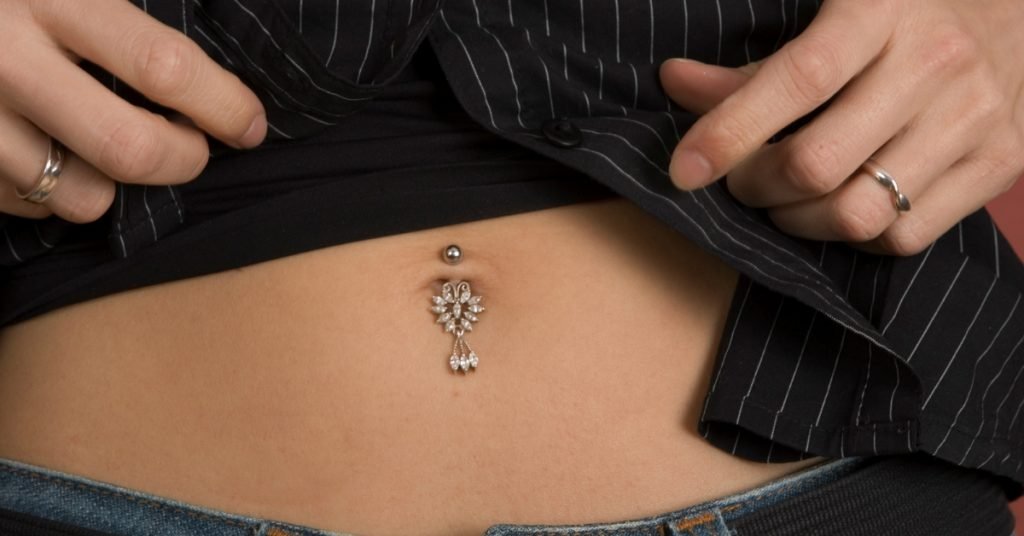
Earlobe piercings are perhaps the most common type of piercing among people because anyone with any level of experience in piercing can do them. For this reason, earlobe piercings tend to heal faster than other types since they do not involve puncturing through cartilage tissue. The gauge sizes for these typically range from 20-12 gauges (2mm-2.5mm).
Nostril piercings also use a variety of jewelry materials like titanium and surgical steel, which allow for quick healing times in comparison to other body jewelry materials. Gauge sizes here usually range from 18-20 gauges (1mm-1.6mm).
Tragus and helix piercings require a slightly bigger hole and thicker gauge due to the thickness of cartilage tissue. Therefore, 16-14 gauge sizes (1.2mm-2mm) are used instead depending on individual anatomy.
Now that we know about the different kinds of body jewelry materials available for various types of earrings, let’s move on to some factors you should consider when selecting an appropriate size earring for your new cartilage piercing!
Factors to Consider
When considering a piercing, it’s important to think about placement, skin type, and healing time.
Placement is key as it will determine both the look of your piercing and its ability to heal properly.
Skin type should also be taken into account since some people may have thicker ear cartilage than others.
Finally, consider the healing time for your piercing as different types of piercings take longer or shorter periods of time to heal completely.
Piercing Placement
You’ll want to consider the placement of your cartilage piercing carefully – over 80% of people with piercings opt for a helix piercing.
When deciding where you’d like to place your cartilage piercing, here are some things to consider:
- The location and size of the jewelry
- Different types of piercing locations
- The material of the jewelry you choose
It’s important to select a piercing location that’s appropriate for your skin type and lifestyle in order to ensure that your new body art looks its best.
-
Product on sale
 Anti-glare UV400 Small Sunglasses for WomenOriginal price was: $53.00.$15.00Current price is: $15.00.
Anti-glare UV400 Small Sunglasses for WomenOriginal price was: $53.00.$15.00Current price is: $15.00. -
Product on sale
 Blue Geometric Earrings for Women$10.00
Blue Geometric Earrings for Women$10.00 -
Product on sale
 Cat Eye Women’s Sunglasses UV400Original price was: $24.00.$12.00Current price is: $12.00.
Cat Eye Women’s Sunglasses UV400Original price was: $24.00.$12.00Current price is: $12.00. -
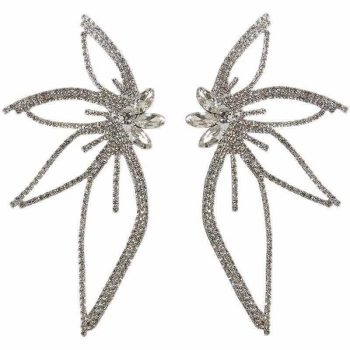 Chic Maple Leaf Zircon Earrings$7.49
Chic Maple Leaf Zircon Earrings$7.49 -
Product on sale
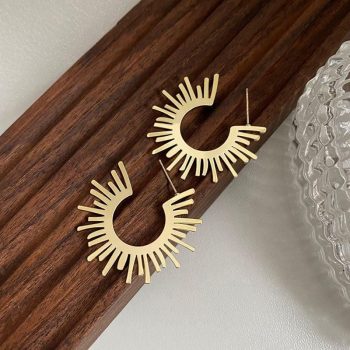 Chic Sunflower Hoop Earrings for WomenOriginal price was: $14.98.$7.49Current price is: $7.49.
Chic Sunflower Hoop Earrings for WomenOriginal price was: $14.98.$7.49Current price is: $7.49. -
Product on sale
 Circle Pearl Earrings for WomenOriginal price was: $34.00.$10.00Current price is: $10.00.
Circle Pearl Earrings for WomenOriginal price was: $34.00.$10.00Current price is: $10.00.
Skin Type
Consider your own skin type when selecting a piercing location for your body art – it’s essential to choose something that looks great on you! If you have sensitive skin, choosing jewelry with softer materials, such as gold or silver, is recommended.
Following aftercare tips will also help ensure proper healing and reduce the chances of infection. Additionally, thinner gauges may be better for those with more delicate skin since they are less likely to cause discomfort during the healing period. With this in mind, it is important to take into account both the size and material of the jewelry when deciding what size earring to get for a cartilage piercing.
As always, make sure to consult with a professional piercer prior to getting pierced.
Moving forward from here, healing time must be taken into consideration before committing to any body art procedure.
Healing Time
Healing times for body art procedures vary depending on the placement of the artwork, but typically take anywhere from four to eight weeks.
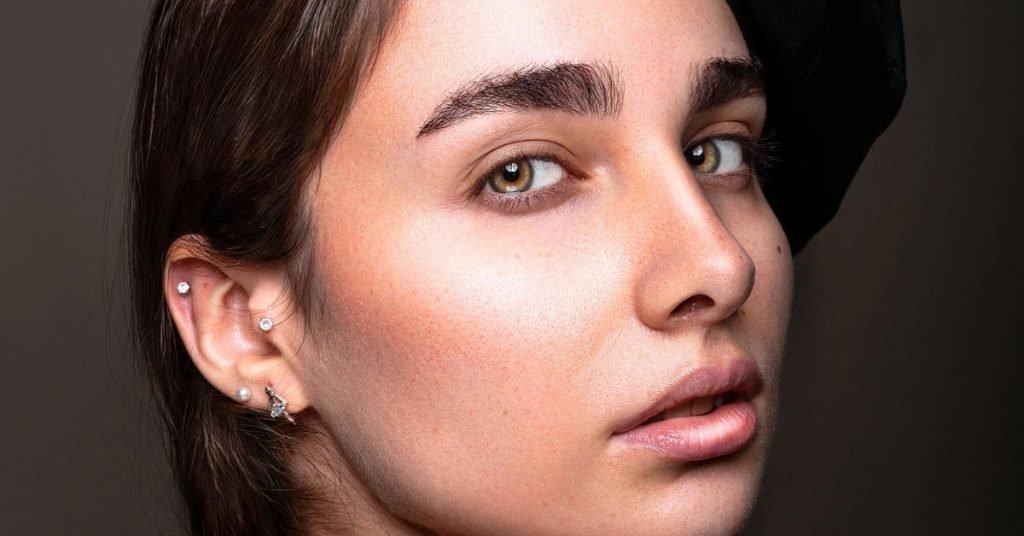
Cartilage piercings are no exception and usually take around six weeks to fully heal. However, taking extra care to reduce infection risk and provide pain relief can help minimize healing times.
| Pain Relief | Infection Risk | |
|---|---|---|
| Cleaning | Avoid touching | |
| Antibacterial Ointment | Change jewelry regularly | |
| Hot/Cold Compress | Keep piercing area dry |
It is important to keep in mind that all healing times depend on individual skin types and other factors. Taking these precautions will not only make your cartilage piercing look great but also last longer than expected without any complications; transitioning us into our next section exploring common earring sizes for cartilage piercings.
Common Earring Sizes
When it comes to cartilage piercings, the most common earring sizes range from 16g – 20g. Here are some tips for determining the best gauge and jewelry material for your piercing:
- Check with your piercer to determine which size is right for you.
- Measurement of gauge is based on how thick the post is.
- Choose jewelry materials that won’t irritate your skin, like surgical steel or titanium.
Your choice of earring size can have an effect on both healing time and comfort. Smaller gauges tend to heal more quickly than larger ones, while thicker gauges offer more stability. However, if you choose a size that’s too small, it may be uncomfortable or even cause irritation in the area around your piercing.

On the other hand, if you choose a size that’s too large for your piercing it could increase healing time and potentially lead to infection. To find out what size is best for you, it’s always best to consult with your piercer before making any decisions about jewelry choices.
No matter which size you ultimately choose for your cartilage piercing, make sure that you take care of it properly during healing by cleaning it regularly and avoiding harsh chemicals in products such as hairspray or lotion. Taking these steps will help ensure that you get optimal results from your piercing and decrease any potential risks associated with improper care.
By taking these precautions when selecting jewelry sizes and caring for them after placement, you’ll be able to enjoy all the benefits of having a unique cartilage piercing without worrying about any potential complications along the way.
Benefits of Different Sizes
Now that you’ve learned about the various sizes of earrings, it’s time to explore the benefits of different sizes for cartilage piercings. Depending on the type and size of earring you choose, you can create a unique style to suit your personality.
Smaller studs offer subtle elegance while larger hoops can make a statement. There are also endless options in between as far as style and shape go for your piercing. Check this post to see how to choose the right earring.
The size of the earring you select will also depend on what type of piercing you have. Studs are most recommended for helix piercings, while rings or hoops are best suited for tragus piercings. You’ll want to be sure to get an earring that is appropriate for the type and location of your piercing in order to ensure comfort and reduce irritation caused by rubbing against clothes or other objects.
Regardless of which size and style you ultimately decide on, there are many options available when it comes to choosing a cartilage earring that suits your individual taste – so don’t be afraid to experiment! And with these tips in mind, you’re ready to move onto exploring the popular cartilage earring styles available today.
-
Product on sale
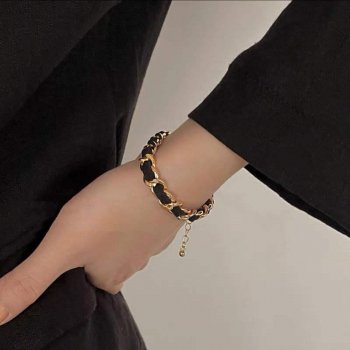 Elegant Vintage Rose Gold Black Woven BraceletOriginal price was: $11.52.$7.49Current price is: $7.49.
Elegant Vintage Rose Gold Black Woven BraceletOriginal price was: $11.52.$7.49Current price is: $7.49. -
Product on sale
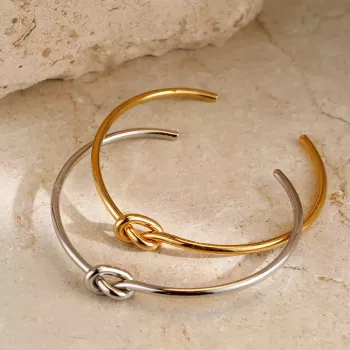 Twist Knot Stainless Steel Cuff BraceletOriginal price was: $8.32.$7.49Current price is: $7.49.
Twist Knot Stainless Steel Cuff BraceletOriginal price was: $8.32.$7.49Current price is: $7.49. -
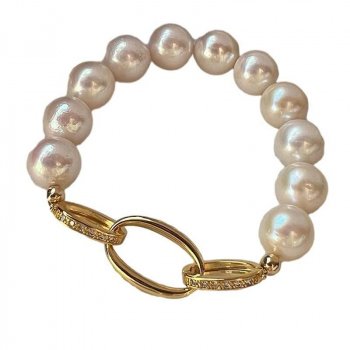 Chic Crystal & Pearl Hand Catenary Fashion Mood Tracker Bracelet$9.49
Chic Crystal & Pearl Hand Catenary Fashion Mood Tracker Bracelet$9.49 -
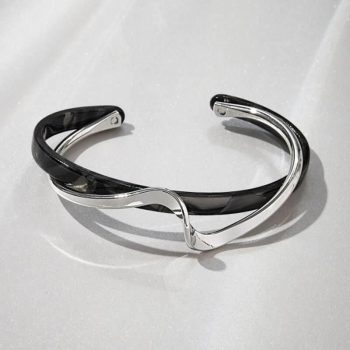 Geometric Metal Charm Bracelet for Women$11.49
Geometric Metal Charm Bracelet for Women$11.49 -
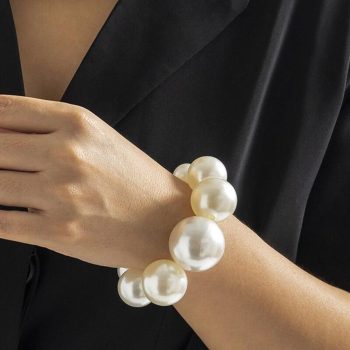 Womens Round Pearl Charm Bracelet$7.99
Womens Round Pearl Charm Bracelet$7.99 -
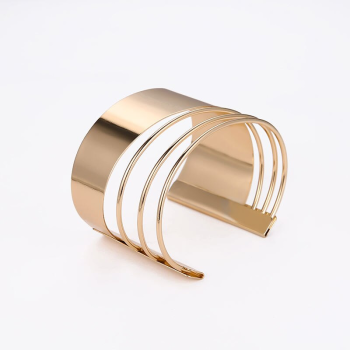 Women’s Bohemian Gold-Plated Geometric Cuff Bangle$6.49
Women’s Bohemian Gold-Plated Geometric Cuff Bangle$6.49
Popular Cartilage Earring Styles
Explore the wide range of earring styles available today and find a unique look to express your personality! When it comes to cartilage piercings, the options are nearly endless. From tiny studs to dangling hoops, you’ll find something that expresses your individual style.
Many people opt for nose piercing jewelry when getting their cartilage pierced as many of these pieces can be used in multiple piercings. Helix piercings look great with small studs or mini-hoops, while larger hoops and dangles create a bolder statement.
Whether you choose something classic or make a statement with color and sparkle, there is an option that will let you express your sense of style.
No matter what type of earring for cartilage piercing you choose, safety and care should be top priority. Before settling on one particular style of earring, consider how much time and effort you can dedicate to cleaning and caring for them properly.
Safety and Care Considerations
It’s important to take safety and care into account when deciding on a piercing style, so make sure you know what kind of time and effort you can dedicate to keeping your jewelry clean.
Personal hygiene is paramount when it comes to piercings, as any dirt or bacteria that accumulates can lead to infection. Aftercare products are available which can help reduce the risk of infection and keep your piercing looking good for longer.
Cleaning solutions, antiseptic sprays, and lotions should all be part of your routine following a cartilage piercing.
It’s also important to avoid changing jewelry too quickly after the piercing has been done. Allow enough time for the area to heal completely before removing or replacing the earring, otherwise you may damage the tissue or cause an infection from introducing bacteria into the wound.

If you do need to change your jewelry during healing, make sure you use new sterile items every time.
The right size earring is essential for comfort and safety during healing; if it’s too tight it will cause discomfort while if it’s too loose then there may be increased risk of snagging or catching on clothing or other items.
Choosing an appropriate size earring for your cartilage piercing is therefore key in ensuring successful healing without any issues down the road. To ensure this happens, consider seeking advice from an experienced piercer about selecting the best size earring for your needs.
Moving forward with selecting the right earring size for you requires taking into account personal preference as well as safety considerations that come with cartilage piercings.
Choosing the Right Earring Size for You
When selecting jewelry for a cartilage piercing, it’s vital to pick the perfect fit – like finding a needle in a haystack! The size of the earring should be small enough that it won’t irritate your piercing or cause discomfort. It should also match any body art and accessory trends you may be following.
To help you find the right size, measure the circumference of your cartilage piercing using a soft measuring tape. This will give you an idea of what size earrings are suitable for your pierced area.
Keep in mind that certain types of piercings may require different sizes according to their location on the body. For example, nostril piercings usually require smaller sized earrings than those used for tragus or conch piercings. In addition, if you have multiple piercings on one side of your face then try to keep all your earrings at similar sizes so they look balanced and proportional when worn together.
The best way to determine which size is right for you is to try on different styles and sizes until you find one that fits comfortably and looks great with your style of body art or accessories. With some patience and experimentation, you can find the perfect pair of earrings for your cartilage piercing! As with any new piece of jewelry, make sure to clean it regularly and follow up with a doctor if any signs of infection appear after wearing them.
-
Product on sale
 Exquisite Design Ladies WatchOriginal price was: $63.00.$27.00Current price is: $27.00.
Exquisite Design Ladies WatchOriginal price was: $63.00.$27.00Current price is: $27.00. -
Product on sale
 Luxury Fashion Womens Wallet$11.00 – $15.00
Luxury Fashion Womens Wallet$11.00 – $15.00 -
Product on sale
 Feminine Wallet Card HolderOriginal price was: $26.00.$15.00Current price is: $15.00.
Feminine Wallet Card HolderOriginal price was: $26.00.$15.00Current price is: $15.00. -
Product on sale
 Long Women Double Zipper WalletOriginal price was: $18.00.$15.00Current price is: $15.00.
Long Women Double Zipper WalletOriginal price was: $18.00.$15.00Current price is: $15.00. -
Product on sale
 RFID Women’s Leather Wallet$17.00 – $21.00
RFID Women’s Leather Wallet$17.00 – $21.00 -
Product on sale
 Long Women Wallets Pu LeatherOriginal price was: $29.00.$15.00Current price is: $15.00.
Long Women Wallets Pu LeatherOriginal price was: $29.00.$15.00Current price is: $15.00.
Summary
Finding the ideal fit for your body art or accessories can be a tricky task, but with some patience and experimentation, you’ll discover the perfect earrings for you.
When considering what size earring to get for your cartilage piercing, there are a few important aspects to take into account. First, consider if you have any allergies that could be irritated by certain metals or gemstones – this will help narrow down the type of earring that is right for you.
Additionally, if you plan on stretching the piercing, it’s important to start off with an appropriately sized jewelry piece so as not to cause any unnecessary damage. Lastly, make sure to follow aftercare tips closely; this includes cleaning your jewelry regularly and rotating it regularly too.
Choosing an appropriate size earring for your cartilage piercing is essential in order to maintain healthiness and comfort in the area pierced. An ill-fitting item can lead to long-term discomfort or even allergic reactions which could interfere with proper healing of the wound site.
This is especially true when deciding between different gauge sizes which indicate how thick a particular item is – selecting too small of a size may cause further irritation while selecting too large of a size may not stay lodged securely enough in place.
It’s always best to consult with an experienced piercer before making any decisions about what type of jewelry is best suited for your individual situation – they can provide valuable advice on what types of materials and sizes will work best depending on where you are planning on having pierced as well as other factors such as skin sensitivity and desired look.
With their expertise combined with some experimentation on your part, you’re sure to find just the right fit!
Frequently Asked Questions

Is it painful to get a cartilage piercing?
Yes, getting a cartilage piercing can be uncomfortable. However, there are pain relief options available and the healing process is typically quick. With extra care and attention to your piercing, you’ll soon enjoy the results!
How much do cartilage piercings usually cost?
The cost of a cartilage piercing will depend on the type of jewelry you choose. Do some research and compare prices before getting pierced. Don’t forget to ask about aftercare advice too!
How long does it take for a cartilage piercing to heal?
It usually takes 6 to 8 weeks for a cartilage piercing to heal. Cleaning your piercing regularly with salt water and aftercare advice are key for successful healing. Follow these tips to ensure you recover quickly and safely!
What is the best type of material for cartilage earrings?
The best type of material for cartilage earrings depends on your jewelry design. Popular types of metals include silver, gold and titanium. Consider what suits you best before deciding.
Is it safe to change cartilage earrings during the healing process?
Changing cartilage earrings during the healing process can be like walking a tightrope: even with careful jewelry choice, you risk infection. So, proceed with caution!
Conclusion on What Size Earring For Cartilage Piercing

Choosing the right size earring for your cartilage piercing can be daunting, but once you consider all the factors and pick the best style for you, it’ll feel like a weight has been lifted off your shoulders.
Think of it as fitting a key into a lock – when you find the perfect fit, everything will fall into place.
Ultimately, it’s important to remember that everyone is different and there isn’t one right answer when it comes to selecting an earring size. You have the power to decide what works best for your unique needs.
Have fun with experimenting and enjoy rocking your new look!
What To Do If Earring Hole Closed
Jul 9, 2023
How Long Is A Standard Earring Post?
Jul 12, 2023

